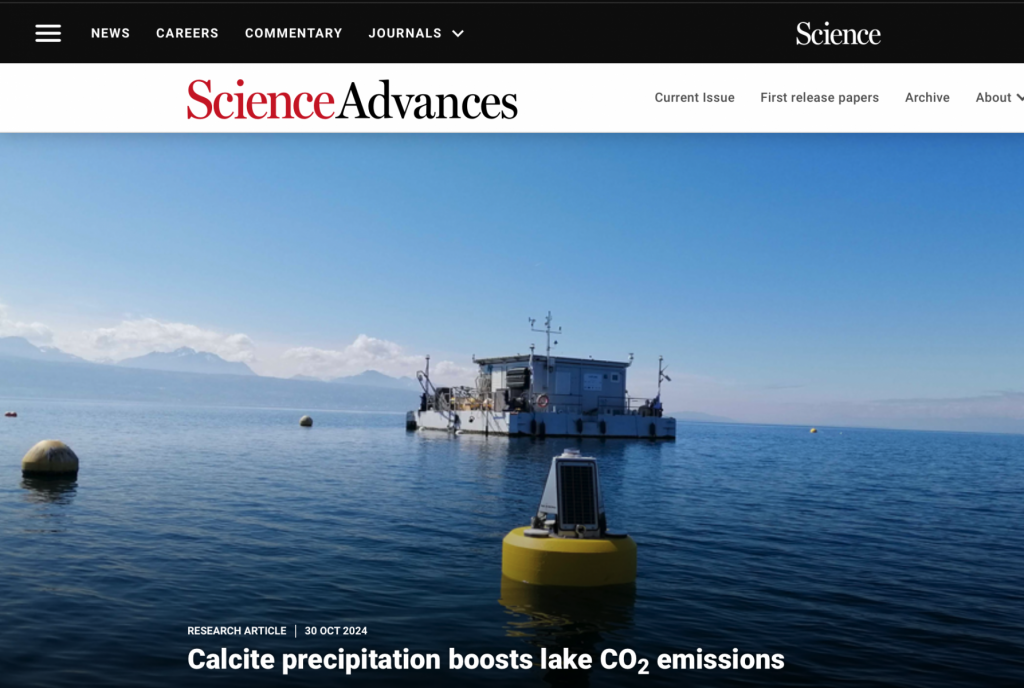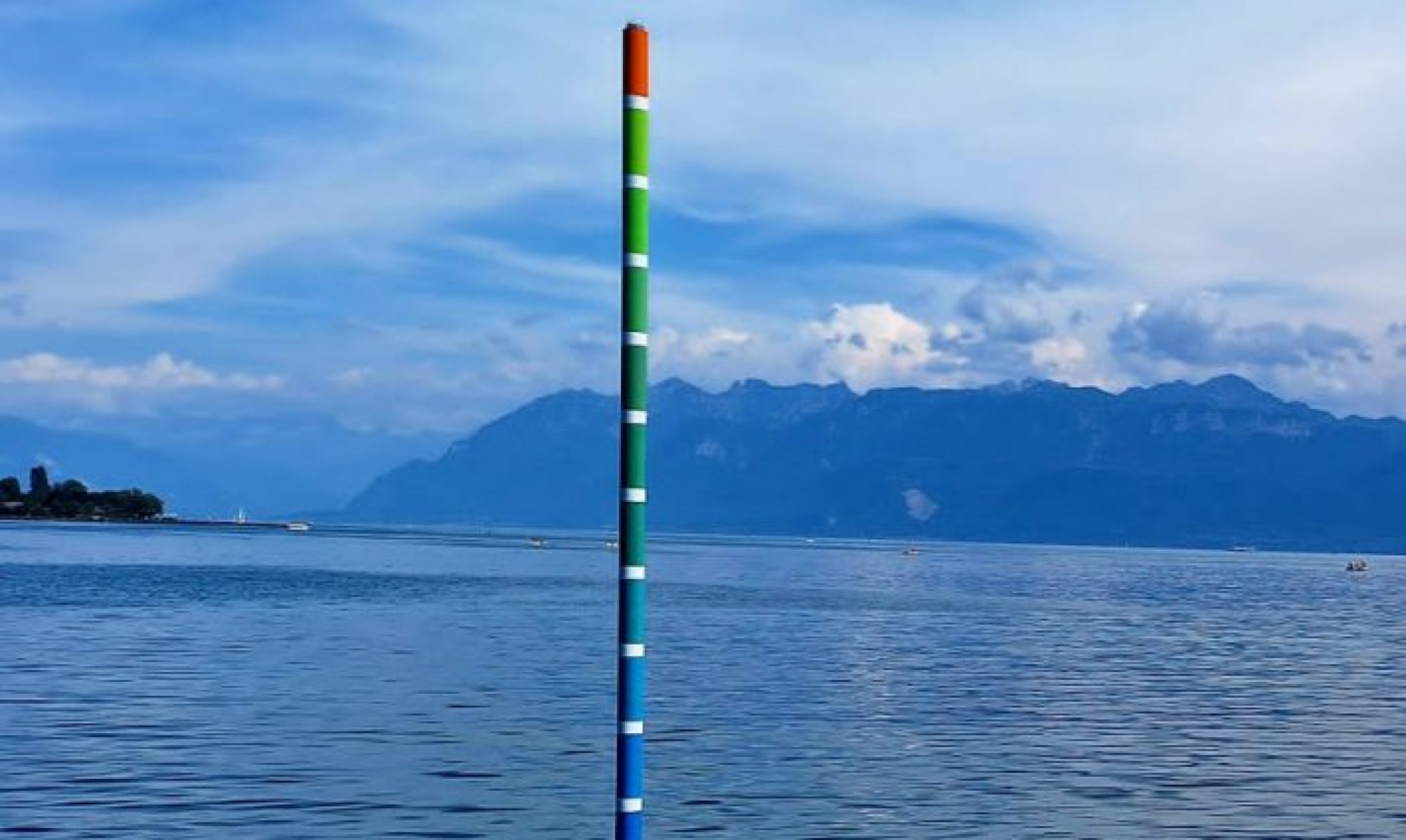Carbon cycle in Lake Geneva
A SNF-funded project (2018-2023)

Motive
The role of lakes and other inland waters as significant CO2 emitters has been repeatedly demonstrated over the last three decades. Global evasion of CO2 from inland waters, which magnitude is comparable to the atmospheric ocean sink, is now accounted for in global carbon models. However, major uncertainties remain on the ultimate causes and drivers of CO2 supersaturation, notably in lakes, limiting our ability to assess and forecast their variability in space and time.
The metabolic theory has long been the core paradigm for lakes’ carbon cycle; i.e., lake metabolism, the balance between inorganic fixation by primary production and release by organic matter mineralization (respiration at large), is the primary mechanism controlling C cycling in lakes. However, the metabolic theory fails to explain how clearwater, autotrophic lakes, such as large Swiss peri-alpine lakes could be CO2 supersaturated, as well as the magnitude and directions of the changes we observed for the last 150 years (Perga et al., 2016). More generally, the reality check from the few available time series on lake surface CO2 has revealed that the metabolic theory could not be verified on the ground (Perga et al., 2016). Notably, Rantala et al. (2021) have shown that surface CO2 in similar lakes with a comparable history of eutrophication and reoligotrophication, exposed to a similar climate, had diverging responses depending on their geomorphological context (i.e., drainage ratio). We hypothesized that the general discrepancy between observations and theory arises from (i) limited coverage of spatial and temporal variability of processes and (ii) overlooked critical mechanisms by which alkalinity, brought by the catchment ‘s hydrological inputs, gets converted into CO2. Those were the working hypotheses of the CARBOGEN project.
Project’s content
We, therefore, opted for an in-depth survey of the carbon processes in lake Geneva. We are unaware of any previous study tying up the whole carbon processes in a lake year-round, and Lake Geneva appeared as an ideal pilot site. First, Lake Geneva is one of the most surveyed lakes in the World. Nevertheless, an attempted heuristic carbon budget based on the wealth of available lake data and its catchment is remarkably unbalanced. Second, Lake Geneva, whereby 95% of the carbon stocks are inorganic, receives alkalinity from its catchment. Regular observations of whiting events (sudden but regular events of massive calcium carbonate precipitation) attests that the lake alkalinity is reactive and might contribute to overall lake C fluxes, offering a unique opportunity to finally deal with the insofar unaccounted inorganic geochemistry in lake carbon cycles. Last, CARBOGEN built upon the unique LeXPLORE infrastructure. LéXPLORE enables the deployment of new approaches to monitor carbon processes at high-frequency (CO2 fluxes at the lake surface from forced-diffusion flux chambers (Perolo et al., 2021), alkalinity, and calcite precipitation (Escoffier et al, 2023). Spatial field samplings and remote-sensing approaches were instrumental also to quantify the spatial and temporal variability of the lake’s carbon processes (Escoffier et al, 2022, Many et al, 2023).
Main results
Published results have addressed carbon processes’ time and space variability. Perolo et al. (2021) showed, for instance, that episodic extreme events with surface waves (6% occurrence) can generate more than 25% of annual net CO2 fluxes in Lake Geneva. The paper also provides a method to estimate gas-piston velocity, accounting for the surface variability in the wind and wave fields. Perolo (2022) also showed that littoral habitats, despite representing <9% of the surface area, can contribute 35-50% of the total lake CO2 emissions. Combining spatial samplings with bioassays (Lambert & Perga, 2019) demonstrated the high biogeochemical reactivity at the Rhône (the largest inflow) estuary, where the lake and river waters mix, leading to non-conservative behaviors of organic carbon processes. Using remote sensing and machine learning, Many et al (2022) showed that whitings could occur from 0 up to 48 days per year between 1958 and 2021 (mean=18 days), and mostly (95%) in the Western area of the lake where the Rhône influence is maximal. The annual frequency of whitings tended to increase for years with greater precipitations, and the timing has shifted to earlier whitings with climate change (Many et al, 2022).
A second phase of the work focused on inorganic carbon geochemistry. While alkalinity is assumed as the primary driver of the CO2supersaturation of hard-water lakes, the mechanisms by which alkalinity converts into CO2 supersaturation remain unexplained. Briefly, alkalinity to CO2 conversion can involve two dominant pathways; (i) the carbonate equilibrium, which is mathematically well constrained and does not affect the total alkalinity, (ii) an alkalinity sink mediated by primary production, primarily through calcite precipitation, which is basically unconstrained (Figure 2). While the carbonate equilibrium is included in most lake C models, we found no models in which the calcite dynamics were coded. Our purpose here was then to constrain the conditions and C fluxes generated by daily calcite precipitation so that we could create a calcite dynamics module to be implemented in a deterministic water quality model AED2.
Combining isotope tracing, geochemical modeling, and remote sensing, Escoffier et al., (2022) could delineate the reasons underlying the specific spatial and temporal distribution of whiting events and address the mechanisms by which high Rhone inflows, rather than phytoplankton blooms trigger those whiting events. However, we found out that whiting events contribute <10% of annually precipitated calcite in the lake and that their contribution to the lake calcite dynamics could be neglected for the final lake C model (Perga et al, 2022).The continuous calcite precipitation during stratification is the dominant alkalinity sink (Perga et al, in prep). Finely time-resolved measures from LéXPLORE showed that alkalinity consumption supported daily primary production for 75% of the year (Perolo et al, 2023) and that calcite precipitation provided enough CO2 to support, on average, half of the daily primary production (up to 100% in the most productive days) (Escoffier et al, 2023).
The modeling step relied on a coupled 1D physical (SIMSTRAT) and water quality (AED2) model to which we added a calcite module parametrized from the results of Perolo et al (2022, 2023) and Escoffier et al (2023). Once parametrized, the model served two purposes. First, we could compute to total carbon budget for lake Geneva, documenting and quantifying the processes by which an autotrophic lake can turn into a CO2 source to the atmosphere. Further simulations are currently run to quantify the role of calcite precipitation versus the carbonate equilibrium in transforming alkalinity into CO2 (Many et al, in prep, Figure 4). We also plan further use of the model to assess the alkalinity threshold at which lakes, despite autotrophic, turn to CO2 sources to the atmosphere, e.g., to predict the threshold whereby the contribution of inorganic biogeochemistry overcomes that of metabolic processes in determining the direction and magnitude of lakes CO2 emissions (Perga et al, in prep.).
Publications
Many, G., Escoffier, N., Perolo, P., Bärenbold, F., Bouffard, D., Perga M.E. 2024. Calcite precipitation: The forgotten piece of lakes’ carbon cycle. Science Advances, 10,eado5924(2024). DOI:10.1126/sciadv.ado5924
Escoffier, N., Perolo, P., Many, G., Pasche, N.T., Perga, M.-E. (2023) Fine-scale dynamics of calcite precipitation in a large hardwater lake. Science of the Total Environment 864, 160699.
Perolo, P., Escoffier, N., Chmiel, H.E., Many, G., Bouffard, D., Perga, M.-E. (2023) Alkalinity contributes at least a third of annual gross primary production in a deep stratified hardwater lake. Limnology and Oceanography Letters, 8: 359-367. https://doi.org/10.1002/lol2.10311
Escoffier, N. , Perolo, P., Lambert, T., Rüegg, J., Odermatt, D., Adatte, T., Vennemann, T., Perga M.E. (in press). Whiting events in a large peri-alpine lake: Evidence of a catchment-scale process. Journal of Geophysical Research: Biogeosciences.
Lambert T, Perolo P, Escoffier N, Perga ME. Enhanced bioavailability of dissolved organic matter (DOM) in human-disturbed streams in Alpine fluvial networks. Biogeosciences. 2022;19(1):187-200.
Perolo, P., B. Fernández Castro, N. Escoffier, T. Lambert, D. Bouffard, and M. E. Perga. 2021. Accounting for surface waves improves gas flux estimation at high wind speed in a large lake. Earth Syst. Dynam. 12:1169-1189.
Rantala, M. V., Bruel, R., Marchetto, A., Lami, A., Spangenberg, J. E., & Perga, M.-E. (2021). Heterogeneous responses of lake CO2 to nutrients and warming in perialpine lakes imprinted in subfossil cladoceran δ13C values. Science of the Total Environment, 782, 146923. doi:https://doi.org/10.1016/j.scitotenv.2021.146923
Bonus
Pour la Science : https://www.pourlascience.fr/sd/geosciences/l-erosion-des-roches-une-source-inattendue-des-emissions-de-co2-du-lac-leman-27238.php
Editor’s highlight : Jack J. Middelburg, Closing the inland water carbon cycle. Science Advances, 10,eadt3893(2024).DOI:10.1126/sciadv.adt3893
